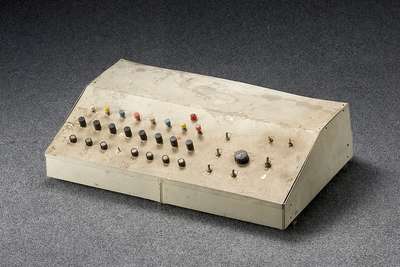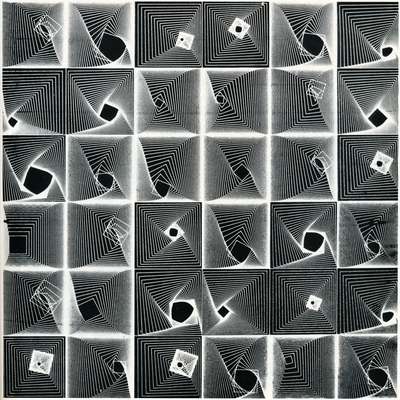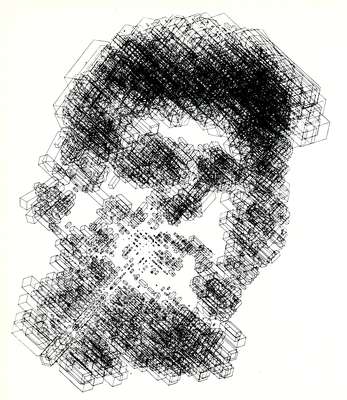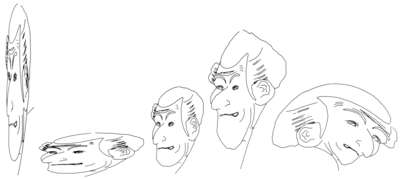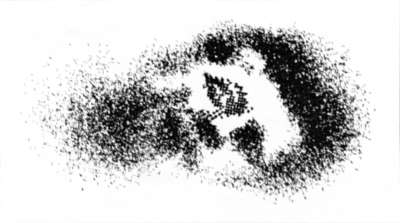The Computer Technique Group was a Japanese collective of art and engineering students founded by Masao Kohmura and Haruki Tsuchiya in the late 60’s and partially funded by the IBM Scientific Data Center.
A chance meeting of Masao Kohmura and Haruki Tsuchiya, both university students in Tokyo, offered the occasion to organise a historic group in computer art, CTG, with two other students, in December 1966.
CTG was not an ordinary artists group. It opened up an office in downtown Tokyo and aimed to have two kinds of activities. As a design office, it managed graphic design works and sold art works to galleries. In parallel, it was a think tank with expertise in computer analysis. CTG members often appeared in journals and on TV. CTG presented a symposium “Computer and Art” in Tokyo on 9 October 1967, and issued the “CTG manifesto” and the “Computer Art is New Art” as a leaflet. Source
The CTG Manifesto, from 1966 explains:
" CTG is an active think tank that takes advantage of well developed electronic computer systems and makes them serve the needs of human beings. We, the post-war generation, have been exploring our place in machine society for all our born days. Living without machines is attractive in its own way in our dreadful age but it is regressive evolution back towards apes, and is different from the creative evolution we are aiming for. We will tame the computer’s appealing transcendental charm and restrain it from serving established power. This stance is the way to solve complicated problems in the machine society. We do not praise machine civilization, nor do we criticise it. By a strategic collaboration with artists, scientists and other creative people from a wide variety of backgrounds, we will deliberate carefully the relationships between human beings and machines, and how we should live in the computer age. "December 1966, CTG, Computer Technique Group:
Haruki Tsuchiya, Masao Kohmura, Kunio Yamanaka, Junichiro Kakizaki
The group was made up of product designer Koumura, Masao, aeronautical architect Makoto Ohtake, aeronautical engineer Kunio Yamanaka, electronics engineer Junichiro Kakizaki and systems engineers Haruki Tsuchiya, Koji Fujino and Fujio Niwa.5
They all worked at the IBM-Scientific-Data-Centre in Tokyo. Their works concentrated on the manipulation of objective motifs using geometric transformations and addressed the principles of Pop Art using image processing.
Their works were selected for the 6th Computer Art contest and six pieces of their computer graphics were included in the August 1968 of the magazine Computers and automation.
From the 2nd- 21st September, 1968 the Computer Technique Group (CTG) showed an exhibition in the Tokio Gallery (Japan), entitled Computer Art: Media Transformation through Electronics.
CTG exhibited two installations, Thermo Field and Plotting Field,and some computer graphics at the International Psytech Art exhibition – Electromagica ’69 at Tokyo. Thermo Field was at first an elaborated plan of a TPM (Thermo Painting Machine). It was planned to finish inner walls with thermal paint and to reproduce pictures by heater controls. However, it was not more than a partial realisation. For Plotting Field, CTG brought a CalComp plotter into the venue and produced drawings on site, of the Kennedy images consisting of alphabetic and symbol characters one after another.
CTG participated in The 6th Paris Biennale in October/November and exhibited three works of computer graphics and an animation Computer Movie No.1 on 16mm film, which was produced by filming computer generated images on an IBM 2250 CRT.
CTG’s art products were exhibited in two new countries after it disbanded.
First at the Computerkunst – on the eve of Tomorrow in Hannover in 1969 and then at the “35th Venice Biennale” in June/October 1970 some computer graphics of CTG were exhibited.
A symposium and film show to commemorate the demolition1 of CTG, “eve of mass computication2 – Exploring the possibilities of computer generated images” was held
at Iwanami Hall, Tokyo, on 22 January 1970.
Tsuchiya enunciated CTG’s dissolution in the leaflet:
" My primary interest is in ascertaining the significance of art for human beings and how it is being realised in our society. This may be an exaggeration, but I say that computer art is a revolt against the whole of technology. . . . Today, new relationships between engineers and artists are expected for computer art. It has become a thing of the past for me." Good-bye, Computer art! – Haruki Tsuchiya
Source
1967/04 CTG コンピュータ・テクニック・グループ
槌屋治紀 幸村真佐男 柿崎純一郎 山中邦夫 藤野孝爾 円羽冨士男 長谷川武 大竹誠 岩下繁昭 佐々木三知夫
(source: http://www.st.chukyo-u.ac.jp/kohmura/CTG/ctg.html)


